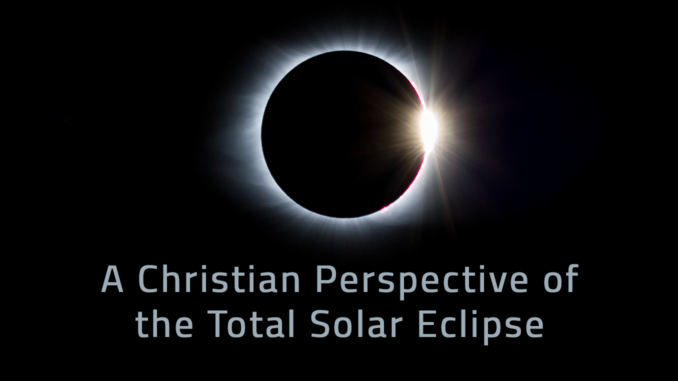
Almost exactly ten years ago, on April 14, 2014, to be exact, I wrote about the upcoming tetrad of “blood moons.” Do you remember the interest that was sparked by this four-part event within an 18-month window? On April 14, 2014, October 8, 2014, April 4, 2015, and September 28, 2015, there were four “blood moons.” These were technically total lunar eclipses. A total lunar eclipse occurs when the moon is in the full moon stage and passes through the Earth’s shadow, darkening the moon’s typically bright glow. During this total lunar eclipse, the moon is entirely immersed in Earth’s shadow and can take on a dusky “blood red” color due to the scattering of sunlight through the edges of Earth’s atmosphere.
Having these four total lunar eclipses in a two-year pattern, known as a tetrad, is very rare. According to NASA, it did not occur even once from 1600 to 1900. One more interesting thought about the “blood moons” of 2014 and 2015: each of them occurred on a Jewish Feast Day. I will leave it to you to research the connection between a tetrad and Jewish Feast days (look up 1492 and the Jews in Spain, or 1948 and the statehood of Israel, or even 1967 and the “Six-Day War”).
The Anticipation of Celestial Events
As we stand on the cusp of another celestial event, those of us in America are again abuzz with anticipation and wonder. On Monday, April 8, 2024, a solar eclipse is poised to captivate our gaze, drawing our eyes upward to the heavens. For some reason that I can’t explain, this event is drawing more interest than any other eclipse during my lifetime. It seems everyone is talking about it, and everyone has an opinion about it. It doesn’t take long to search online to find all the conspiracy theories. I recently read one article on wired.com stating, “Kate Middleton and the Baltimore Bridge collapse were just warm-us. For conspiracists in 2024, the total solar eclipse taking place is their Super Bowl.”
Yet, for believers, such events hold a deeper significance beyond their awe-inspiring beauty. From a Christian perspective, the upcoming solar eclipse reminds us of the intricate tapestry of creation woven by the hand of God and forces us to reflect on its prophetic implications, particularly in the context of the end times as foretold in the Scriptures.
Celestial Phenomena in the Bible
In the Bible, celestial phenomena often carry profound spiritual meanings, serving as signs and symbols of God’s sovereignty and His divine plan for humanity. In the book of Genesis, we read of the creation account, where God sets the sun, moon, and stars in the sky to mark seasons, days, and years (Genesis 1:14-15). From the very beginning, the celestial bodies were ordained by God to declare His glory and to serve as signs for His people.
Throughout Scripture, eclipses (both solar eclipses and lunar eclipses) are sometimes used as symbolic language to depict cosmic disturbances that accompany significant events, especially those pertaining to the end times. Jesus Himself alluded to such signs when He spoke about the signs of His return in the Olivet Discourse recorded in Matthew 24, Mark 13, and Luke 21. In Luke 21:25-26, Jesus says, “And there will be signs in the sun, in the moon, and in the stars; and on the earth distress of nations, with perplexity, the sea and the waves roaring; 26 men’s hearts failing them from fear and the expectation of those things which are coming on the earth, for the powers of the heavens will be shaken.”
Here, Jesus paints a vivid picture of the cosmic upheaval preceding His return. While eclipses may not necessarily be the exact signs He referred to, they serve as a reminder of the cosmic events that will mark the culmination of human history. They prompt us to heed Jesus’ admonition to be vigilant and spiritually prepared for His coming.
Reflecting on God’s Sovereignty and Our Readiness
The book of Revelation contains numerous references to celestial phenomena and their significance in the eschatological narrative. In Revelation 6:12-14, John describes a series of cosmic disturbances heralding the Day of the Lord:
12 I looked when He opened the sixth seal, and behold, there was a great earthquake; and the sun became black as sackcloth of hair, and the moon became like blood. 13 And the stars of heaven fell to the earth, as a fig tree drops its late figs when it is shaken by a mighty wind. 14 Then the sky receded as a scroll when it is rolled up, and every mountain and island was moved out of its place.”
Here, the darkening of the sun and the reddening of the moon bear a striking resemblance to the phenomena observed during the eclipses of the last several years. While Revelation employs vivid imagery to convey spiritual truths, these descriptions evoke a sense of awe and reverence for the power and majesty of God’s ultimate judgment upon the earth.
As we contemplate the upcoming solar eclipse, let us not be consumed by fear or speculation about the end times, but rather let us be reminded of the sovereignty of God over the cosmos. In the midst of uncertainty and turmoil, we find comfort and assurance in the words of Jesus: “Heaven and earth will pass away, but My words will by no means pass away” (Matthew 24:35).
Furthermore, the eclipse serves as a poignant reminder of the need for spiritual readiness. Just as the sun is temporarily obscured during an eclipse, so too can the light of God’s truth be dimmed in our lives by the cares and distractions of this world. As followers of Christ, we are called to shine as lights in the darkness, reflecting the glory of our Creator in a world shrouded by sin and despair (Matthew 5:14-16).
So enjoy the upcoming solar eclipse and let it serve as a reminder that while we may not know the exact timing of Jesus’ return, we can take comfort in the assurance that God remains sovereign over all creation. As we witness the celestial spectacle unfolding before our eyes, may it serve as a reminder to fix our gaze upon the author and finisher of our faith, Jesus Christ, who holds the future in His hands. Let us, therefore, live with faith, hope, and expectation, eagerly awaiting the day when the sun will be darkened no more and the Son of God will reign forevermore.
He who testifies to these things says, “Surely I am coming quickly.” Amen. Even so, come, Lord Jesus! (Revelation 22:20)


Thanks for this article. Over the centuries many have worshipped the sun. In ancient Egypt Ra, the sun god was the most prominent. Later Amon-Ra combined two gods to make the most important and powerful god. It is interesting that a few thousand years before Egypt worshiped Ra that the God of the Bible, Jesus Christ, made the sun, moon, and earth so that every now and then an eclipse would completely blot out the sun or the moon. This shows who is really in charge of the universe.
Isn’t it amazing that TV evangelists take great pains to talk about this eclipse? John Hagee is one of those people, and by his own admission he sold an abundance of books regarding the last 4 blood moons. Throughout history many solar and moon eclipses have occurred and none of those resulted in a cataclysm. The Navajo Nation stay indoors, pray and meditate during this eclipse and warn to be somber and they do not eat nor go outside, out of reverence. As Christians we need to be vigilant at all times, regardless of possible heavenly events. We are to be ready for His appearing and not base our faith on events such as eclipses, weather patterns, world weather patterns etc. If the results in the rapture then I say: great, I am glad we are out of here. If not, then we look forward to that event. Meanwhile, let’s keep our faith based on God’s Word, and stop speculating.
The Book of Revelations is a guide for Christians to watch for the return of Jesus Christ. World events, weather changes, among other signs are written to warn and prepare us for his return, not speculation. If it were speculation, there wouldnt be revelations to teach and show us what to look for.
GOD bless everyone and your families.